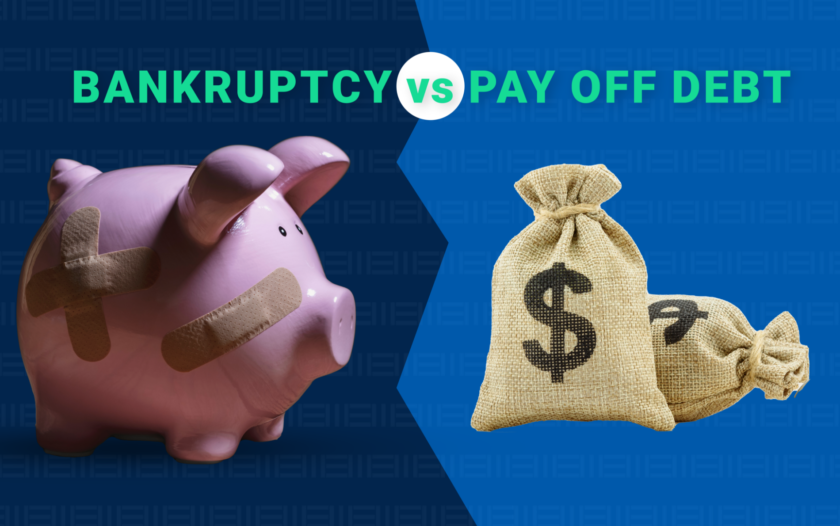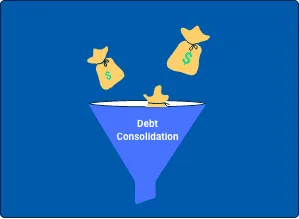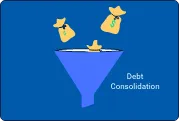Is It Better to Pay Off Debt or Declare Bankruptcy?
About Caitlyn
Caitlyn is a freelance writer from the Cincinnati area with clients ranging from digital marketing agencies, insurance/finance companies, and healthcare organizations to travel and technology blogs. She loves reading, traveling, and camping—and hanging with her dogs Coco and Hamilton.
Read full bio
At a Glance
Filing for bankruptcy may seem like your only option, especially if you feel like you’re drowning in debt and have struggled to pay it off. It can feel like the best way out, stopping contact from collection agencies, wage garnishments, and even potential lawsuits. It can also eliminate various types of debt like credit card debt, medical bills, personal loans, and more.
However, filing bankruptcy doesn’t clear all debt, and can have a significantly negative impact on your credit score and future finances. Deciding whether to pay off debt or declare bankruptcy is a huge decision that shouldn’t be taken lightly, but the good news is you have options.
In this article, you’ll find information about:
Bankruptcy vs. paying off debt
If you have debt, chances are you’ve spent time, effort, and earnings trying to pay it off. You may feel like your only option is to file bankruptcy and try to start over. However, there are both positive and negative consequences for filing for bankruptcy vs. paying off debt, so it’s important to understand your own financial situation and goals to decide which path is right for you.
Filing bankruptcy
How filing bankruptcy works depends on the type of bankruptcy you file. There are two primary types: Chapter 7 and Chapter 13.
When you file Chapter 7 bankruptcy, you must file a petition with the bankruptcy court in your area, including a detailed outline of your assets and liabilities, income and expenses, statement of financial affairs, tax returns, and other documentation proving your financial circumstances.
Then, the court decides which of your assets to sell to repay your creditors. The remaining debt will be discharged except for student loans, child support, taxes, and alimony, which stay on your credit report for 10 years. While most debt will be cleared through the selling of your assets, you may have the option to pay some creditors in order to keep possession of your car or home.
On average, filing Chapter 7 bankruptcy takes about three to four months to complete.
With Chapter 13 filing, you have the opportunity to keep more of your assets while also canceling some of your debts. Whatever debt isn’t discharged will be put on a three to five-year repayment plan, and will stay on your credit report for seven years. Chapter 13 acts like a consolidation loan where you make payments to a trustee who then distributes those payments to creditors.
Related: Debt Consolidation or Bankruptcy
Chapter 13 bankruptcy can take several years because you’ll likely have to pay back some of your unsecured debts through a repayment plan. Unsecured debt that remains after the repayment plan will be discharged.
When you file bankruptcy, the court puts an automatic stay order in place. This means creditors must stop calling you, eviction processes must be halted, and foreclosure or repossessions must stop (for the time being). This gives you time to get your finances in order or get your debt cleared.
Does bankruptcy clear debt?
While most people believe bankruptcy allows you to clear all debt and start fresh, that’s not necessarily always the case.
There are two types of debt: secured and unsecured.
- Unsecured debt, such as credit card debt, medical bills, overdue utility payments, personal loans, etc. have no collateral and are typically cleared by filing bankruptcy.
- Secure debt, such as a mortgage or auto loan, uses your asset as collateral. Though the debt may be cleared, you could lose the asset. For example, if you default on your mortgage, your home could be foreclosed and you’d lose the house.
Other debt that bankruptcy cannot clear includes child support, alimony obligations, most student loans, tax debts, and other debts not listed in the bankruptcy papers.
How can I get out of debt without filing bankruptcy?
There are several things you can do to get out of debt without having to file for bankruptcy. In fact, you should try as many avenues as you can before considering filing.
Debt repayment plans or loan payoff calculators can help you determine which debt to pay off first, at what rate, and when you’ll be debt-free so you have a date to look forward to.
1. Budgeting
Budgeting can not only help you understand your spending habits but also allows you to make a clear plan for changes and adjustments that will help you pay off debt faster.
Start by calculating your monthly take-home income. If you freelance or have an unfixed income, use the average of the past 6-12 months. Then, add up all of your necessary and unnecessary monthly expenses such as your mortgage, utilities, internet, cell phone, groceries, gas, entertainment, etc.
Once you know how much you make and how much you spend, you can start setting goals and making spending cuts where you can. All extra funds should be put toward paying off debt.
2. Balance transfer credit card
A balance transfer credit card is a credit card with a low or 0% interest rate that you would use to pay off an existing, high-interest card. The idea is that the lower rate will save you money, though this rate is typically for a limited time and you must pay it off before that introductory period is over.
3. Consolidating debts
When you consolidate your debt, you’re combining multiple debts into one loan, usually with a lower interest rate. This can help save you money on interest and allow you to manage your debts easier. There are different types of loans to consolidate debt, such as debt consolidation loans, home equity loans, and 401(k) loans, and using a debt consolidation calculator can help you estimate your savings and a timeline to being debt-free.
4. Earning extra income
Starting a side hustle, working an extra shift, picking up a second job, or selling belongings that you no longer need are all ways to earn extra income that you can put toward paying off your debt. There are a number of ways to make extra money, so find one that works for you to pay off your debt faster.
5. Creating a debt repayment plan
There are two primary debt repayment plan strategies: the debt snowball method and the avalanche method.
Snowball method
The snowball method focuses on paying off debts in order of smallest to largest, which helps you gain momentum, stay motivated, and pay off your debts faster.
To start, order all of your debts from smallest to largest, regardless of interest rate. Don’t include your mortgage. Focus on paying off the smallest debt first while continuing to make minimum payments on your other balances. Then, pay off the next smallest debt, and so on, until you’re debt-free.
Get started by using a debt snowball calculator which can help you estimate your savings, figure out which of your debts to repay first, and how much to put toward your lowest balance. You’ll also get an estimated timeline for when your debt will be repaid.
Avalanche method
When you use the avalanche method, you first pay off the debt balances with the highest interest rates. Continue to make minimum payments on all of your debts, but put all extra funds toward the debt with the highest interest until it’s paid off. Then move on to the next highest interest, and continue until they are all repaid.
This method is great for saving you money on interest in the long run. To estimate your savings and start creating a plan, use the debt avalanche calculator.
Psst! Are you losing sleep over debt?
Choose an option:

I am ok taking another loan If I save in the end
I am never taking another loan I can do it yourself
What are you struggling with right now?


Unmanageable Debt?
Debt consolidation can help you lower your monthly payment, decrease your interest rate, pay off your debt faster, and save you money.
What are you struggling with right now?
Unmanageable Debt?
We’ll plug your information into our debt payoff calculator to estimate how much you can save with Payoff Plans.
How to file bankruptcy on credit cards
If you have credit cards and file for bankruptcy, they will likely automatically be closed once you file for bankruptcy. The filing will also likely clear your credit card debt, but can significantly impact your credit score and stay on your credit report for seven to 10 years.
To file bankruptcy on credit cards, first determine whether you want to file Chapter 7 or Chapter 13. Chapter 7 will likely clear all of your credit card debt but you may put your assets, such as your car or home, at risk. Chapter 13 allows you to pay off your debts with a repayment plan, though you’ll likely pay less than what you originally owed.
Paying off debt vs. settling debt
While paying off your debt means you continue to make payments on your debt until it’s gone, settling debt likely requires hiring a lawyer or debt-settlement company to help you negotiate with creditors to pay less than what you owe. In the end, you’d be able to make one lump-sum payment and be debt-free.
The downside to settlement is that some companies are not open to it, and they don’t have to be. The other downside is that while you may be able to negotiate a lower sum, you’ll still have to pay for part of your debt, even up to 75% of what you owed. Additionally, your lawyer or debt-settlement company will likely charge you a fee, and the government can tax your savings as income when you file your next tax return.
Is it better to settle debt or file for bankruptcy?
Paying off debt can take a long time and significant effort, motivation, and self-discipline. Additionally, depending on your interest rates, you may end up paying more than you originally owed.
Settling debt or filing for bankruptcy may seem like a faster, easier way to get out of debt, but they aren’t necessarily the best options for everyone. When you settle debt, you’ll still have to pay back some of what you owe, and you’ll likely be charged fees. Filing for bankruptcy puts your assets at risk, and you may still have to pay back some debts over a period of time anyway. Both can also significantly reduce your credit score.
That said, bankruptcy is probably the fastest way to get out of debt, taking only a few months in some cases. Debt settlement doesn’t require a court filing and sometimes can be handled without a lawyer, but may take more time.
Debt settlement may be better if:
- You are willing to negotiate with creditors or debt collectors, or work with a lawyer or debt settlement company to do so on your behalf.
- You’re able to afford and stick to a settlement plan or make a lump-sum payment.
- You have a stable income that allows you to pay your other essential bills in addition to your debt settlement payments.
Bankruptcy may be better if:
- You’ve exhausted all other debt-relief options.
- You’re in danger of eviction, foreclosure, or repossession of your assets.
- You cannot make payments on your debt without resorting to payday loans or other additional loans.
- Getting out of debt will take you more than five years.
FAQs
When you file for Chapter 7 bankruptcy, most of your debt goes away. However, any assets you own may be sold and used as collateral to pay off those debts. With Chapter 13 bankruptcy, you’ll likely pay back some of your debts over a period of three or five years. Debts that bankruptcy cannot clear include child support, alimony obligations, most student loans, tax debts, and other debts not listed in the bankruptcy papers.
The biggest downside to filing for bankruptcy is the impact it will have on your credit score, decreasing it by 100-200 points or more. Because bankruptcy stays on your credit report for 7-10 years, this can have a long-term impact. The other significant downside is if you file Chapter 7, assets such as your car or home can be foreclosed or repossessed.
If you file for bankruptcy, your credit score will likely decrease significantly – sometimes by up to 200 points or more. This may make it extremely difficult to secure funding, a credit card, a loan, or even employment in the future.
There’s no level of debt that is a surefire tipping point for filing bankruptcy. However, many bankruptcy lawyers will advise you not to file bankruptcy if you have less than $10,000 in dischargeable debt. The reason for this is since legal fees, filing costs, or personal loans for bankrupts, among other items, will all likely cost more than the $10,000 in debt you have outstanding.
When looking at debt relief vs. bankruptcy, it can be confusing who pays for bankruptcies. In most cases, the person who pays for bankruptcies is the person who files in court. Court fees and attorney fees are paid for by the filer who, in most cases, is the person filing for bankruptcies.
The general rule of thumb is that if your total unsecured debt is more than 50% of your annual income, you may be in financial distress enough to the point of considering filing for bankruptcy. This means that if you earn less than $40,000 per year, $20,000 in debt could be reason to file for bankruptcy.









